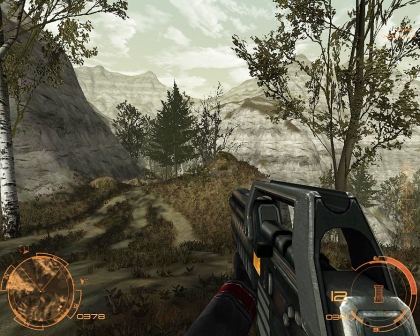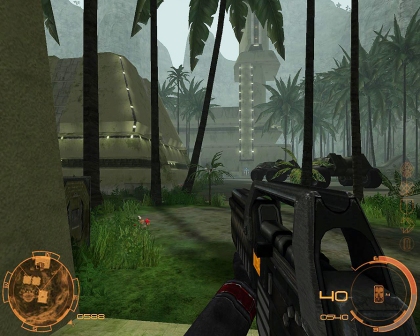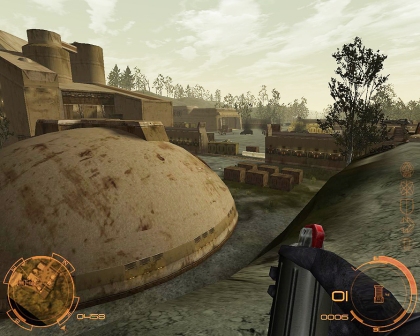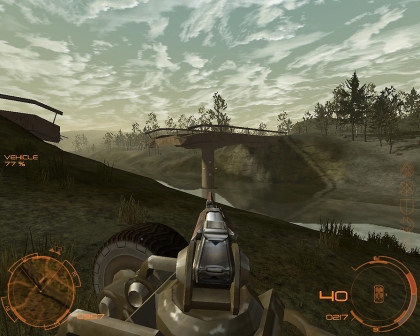Filed under: Chrome Specforce
 Before starting this post, I sauntered over to a few game review sites to read prior opinions about “Chrome Specforce” (2005). I like to see how folks were responding to these older games at the actual time of their release, and to see if the titles (and the reviews) have withstood the test of the ages (or in this case, six whole years). One of those places was Gamespot, and I noticed the strangest thing: Posted there is a little flurry of user-reviews, all written within the last year. But why? Why are there suddenly a bunch of reviews for a generally unknown title more than half a decade old? Then, I learned that “Chrome Specforce,” and the game that preceded it, “Chrome” (2003), were just released on Steam for a whopping $4.99 each. Apparently excited by the tween-allowance-friendly price tag, the kiddies, never having heard of the Chrome series of games before, are downloading and playing it. Of course, they are also taking the opportunity to edify us how Chrome is just a “lame ripoff of Crysis, man.”
Before starting this post, I sauntered over to a few game review sites to read prior opinions about “Chrome Specforce” (2005). I like to see how folks were responding to these older games at the actual time of their release, and to see if the titles (and the reviews) have withstood the test of the ages (or in this case, six whole years). One of those places was Gamespot, and I noticed the strangest thing: Posted there is a little flurry of user-reviews, all written within the last year. But why? Why are there suddenly a bunch of reviews for a generally unknown title more than half a decade old? Then, I learned that “Chrome Specforce,” and the game that preceded it, “Chrome” (2003), were just released on Steam for a whopping $4.99 each. Apparently excited by the tween-allowance-friendly price tag, the kiddies, never having heard of the Chrome series of games before, are downloading and playing it. Of course, they are also taking the opportunity to edify us how Chrome is just a “lame ripoff of Crysis, man.”
Yeah, you do the math.
Sometimes I need an excuse—any excuse—to pull the old, unplayed titles off my shelf and wrestle my 64-bit Windows 7 OS to the ground, forcing it to boot these “ancient” programs properly. In this case, my foggy reason for deciding to dip back into time and give “Chrome Specforce” a try had to do with the recent zombie-slaying coop title “Dead Island,” which I was deeply engaged playing cooperatively with my partner over system link on our Xboxs. As you might be aware if you paid attention to such things, both titles were produced and published by the Polish developer “Techland,” and actually both games use different iterations of the same graphics engine. “Dead Island” proudly displays the “Chrome 5” symbol every time it starts up; somewhere around eight years ago, it was the “Chrome 1” engine that brought, surprise, the “Chrome” series of games to a wowed public (I’m being a little facetious). Not that I’m a graphics engine expert, and not that this post will actively compare these games or chart the nine-year evolution of Techland’s proprietary engine or anything like that. (I could pretend to be qualified to lead such a discussion, but I’m not). I just needed an excuse to go back in time and play an old game. Gorging myself on Techland’s latest and greatest offering of rotting zombie flesh (“Dead Island” really is a large and visually arresting, though buggy, affair) seemed like a good reason to reach back and play one of their earlier titles. Excuse-making like this (to force me to crack open some of these older boxes collecting dust on my shelf) is especially important when I’ve got 3 or 4 titles less than 6 months old demanding my immediate attention. (“Rage” anyone? “Gears of War 3” anyone?) But those new kids can wait patiently. They always do.
every time it starts up; somewhere around eight years ago, it was the “Chrome 1” engine that brought, surprise, the “Chrome” series of games to a wowed public (I’m being a little facetious). Not that I’m a graphics engine expert, and not that this post will actively compare these games or chart the nine-year evolution of Techland’s proprietary engine or anything like that. (I could pretend to be qualified to lead such a discussion, but I’m not). I just needed an excuse to go back in time and play an old game. Gorging myself on Techland’s latest and greatest offering of rotting zombie flesh (“Dead Island” really is a large and visually arresting, though buggy, affair) seemed like a good reason to reach back and play one of their earlier titles. Excuse-making like this (to force me to crack open some of these older boxes collecting dust on my shelf) is especially important when I’ve got 3 or 4 titles less than 6 months old demanding my immediate attention. (“Rage” anyone? “Gears of War 3” anyone?) But those new kids can wait patiently. They always do.
Although I’m rolling my eyes at the kiddies who are discovering, downloading, and playing this title over Steam for the first time, actually their anachronistic “Crysis” comparisons aren’t far off. Though you’d have to make the argument in reverse, Techland’s “Chrome Specforce” really does play like the older, less-developed, less-suave, less-refined, country bumpkin sibling of the well-groomed, smooth-talking, city slicker “Crysis.” Most of this comparison has to do with the suit of high tech armor you, playing Bolt Logan (what a name!), wear throughout the campaign, providing you a menu of special abilities including (let’s recite these in unison, now): 1) high-powered shields, 2) next-to-invisible cloaking, 3) a fast run, and 4) the crowd favorite–a neural boost that slows time so you can more easily hit moving targets. (I wonder if anyone has actually charted the history of the persistent videogame concept of high-tech armor that slows time? It is such a repeated staple, I’d like to see a graphical representation of it somewhere, noting its origins and deviations, including a comprehensive list of titles using this rather conventional trick. That would be neato. And I don’t have time to do it, so someone else has to. On the other hand, time wouldn’t be an issue if I used a time-bending suit of armor to get it done more quickly somehow…anyway, I digress.)
The narrative in “Chrome Specforce,” like just about everything else in the game, is not particularly noteworthy. And before I proceed, I guess couching this discussion in its proper historical context matters. Apparently, the 2003 game “Chrome” was well-liked, even praised critically. However, when the prequel appeared several years later and hadn’t improved upon the original recipe in any significant way, everyone pretty much dismissed it. (I’ve personally not played the 2003 “Chrome” game; I own it and will play it eventually, but since, narratively speaking, “Chrome Specforce” (2005) occurs first as a prequel, I thought I would play these titles in reverse order, just because I’m ornery that way). Being a connoisseur of videogame garbage, I often find games that on their own merit are pretty terrific–but just because they are much-anticipated follow-up titles that can’t meet hyped expectations, people end up dismissing them. Such is the life of a younger sibling…
“Chrome” was well-liked, even praised critically. However, when the prequel appeared several years later and hadn’t improved upon the original recipe in any significant way, everyone pretty much dismissed it. (I’ve personally not played the 2003 “Chrome” game; I own it and will play it eventually, but since, narratively speaking, “Chrome Specforce” (2005) occurs first as a prequel, I thought I would play these titles in reverse order, just because I’m ornery that way). Being a connoisseur of videogame garbage, I often find games that on their own merit are pretty terrific–but just because they are much-anticipated follow-up titles that can’t meet hyped expectations, people end up dismissing them. Such is the life of a younger sibling…
That might sound like I am coming to the rescue of this game with horns trumpeting all around…but really I’m not. (Neither am I panning this title though.) Back to the serviceable narrative: As Bolt Logan, you are a member of Federal Expeditionary Corps, super cool soldiers with super cool gear to do super cool dangerous stuff. Yeah, you’re a regular-sized Master Chief, I guess (and with about as much characterization in that Bungie title—in other words, next to none). In this case though, the problem being solved is much more domestic than alien (which, to me, makes it feel much more grown up), and it concerns the megacorporation Lore-Gen, a drug manufacturer (complete with its own well-equipped militia) who may be moving “product” through galactic mafia folks, or something like that, and causing general havoc by also conducting illegal genetic testing. You and your AI partner, Pointer, are tasked literally with blowing up Lore-Gen’s manufacturing facilities on the planet Estrella (which looks suspiciously like the forests, swamps, and mountains of Earth—sorry folks, no “way out” sci-fi stuff here). Not soon after starting your mission, your ship in orbit (which is carrying your commander and remainder of the crew) is shot out of the sky by Lore-Gen…who shouldn’t have known you were there at all! Gasp! There’s a mole in our midst! Not soon after this turn of events (and now stranded on Estrella), you discover a big group of rebels on the planet whose goals mirror your own—to take Lore-Gen and its army down! From this point on, you and Pointer assist the rebels in a variety of high-tech, life-threatening, globally-defining missions…all of which involve running through jungle A, pushing a button in Building B, driving over mountain C, pulling a lever in Laboratory D, jogging through  swamp E…you get the idea. It’s 2005, after all. Pushing buttons and pulling levers never seemed so important!
swamp E…you get the idea. It’s 2005, after all. Pushing buttons and pulling levers never seemed so important!
To break up the jungle-slogging, Techland peppers this title with a few car / tank / ground speeder / mech missions that are probably the highlight of the game. Having to closely follow comrades on a levitating ground speeder through a thick forest while being shot at from the air was genuinely fun. Similarly, blowing away tanks and rocket launcher-weilding Lore-Gen shock troopers with your own missle-laden mech was a blast (although steering the Walkers leaves a bit to be desired, and bumping into anything—even a small tree—depletes the Walker’s integrity, which seems a bit silly).
Aside from these few standout moments, though, the majority of the game is serviceable at best. In fact, that word can pretty much describe almost everything in the game (except a few elements that don’t even clock in at serviceable). The controls, the look, the weapons, the AI, the variety of gameplay…all of it works. And by that I mean it’s not broken (not high praise, but hey). In 2011, the “my-eyes-are-bleeding-at-how-beautiful-the-graphics-are” impact (of this 2005 game) is diminished of course. Similar to (but way better than) the apocalyptically-poor “Breed,” this title is characterized by wide open outdoor spaces, and clearly one of the strengths of the Chrome engine, even in this early iteration, seems to be its draw distance and ability to render relatively realistic vegetation. (I’ve included a screenshot here of the 2011 “Dead Island” trees next to the 2005 “Chrome Specforce” trees just to make a point.) But also much like “Breed,” the massive areas in which you play are generally “light” on detail, other than some repeating tree-and-boulder patterns. This, of course, can be forgiven considering the game’s age. One gripe: The color seems off, especially those in the green spectrum. It may be a calibration problem with my monitor, but the trees and grasses throughout the game seem to look closer to “lime” than to a lush, deep jungle-or-forest green. This is perhaps an artistic means of emphasizing the otherworldliness of the planet Estrella where the game occurs, but it didn’t work for me—I just kept wanting all the greens to be a little more realistic. Having said that, the game was probably a pretty decent looker in its day (though some textures, especially flat, grassy areas, leave a bit to be desired). Unfortunately, “Specforce” doesn’t support widescreen resolutions. While there are a few widescreen fix ideas out there (Googling it will bring up several threads about what files in the game directory need editing), using them creates two problems. One, the field-of-view gets funky (all spread out), so things look “squashed,” including the HUD, and correcting it is apparently difficult if you don’t know programming. Second, a much bigger issue is that the on-screen fonts become so small when using high-def resolutions that you literally cannot read them. This impedes gameplay because part of the game requires you to hack computer terminals by performing a rather simple matching game (sort of like the old television show Concentration)—which is not so simple if you can’t see the symbols properly. After trying to fiddle with some elements to offset these problems, I ended up just sticking with the highest native resolution  at which the game runs, which is 1260×1024.
at which the game runs, which is 1260×1024.
As usual there are a bucketload of niggles I have with the game—mostly minor technical issues that should have been ironed out long before the price tag was attached. Interestingly, the most irritating ones, for me, have to do with the sound. The environmental and weapon sounds, beyond just being generic, are uninspired, too faint, or too thin, or too infrequent to really immerse the player. One little grasshopper chirping once amidst a massive forest…well, it just doesn’t cut it. The sound of the wind will suddenly disappear and reappear depending on where your character is positioned next to a cliff or tree, also disrupting immersion. And one technical issue, which may have been with my install: Without fail, the last two or three words of any dialogue exchange would be cut off—interrupted by the next person speaking. Thankfully text on screen ameliorated the issue. And, of course, the voice acting is atrocious. This is one of those games that you wish had never been localized to English—bad acting, when it occurs in a language other than your native tongue, is much easier to handle for some reason. Here, I would have been as happy as an ignorant tourist in a foreign land to simply read English text and have some bad German or Russian or French voice actor blather away. But no. Here we are treated to English “actors,” all of whom sound either like they are reading from cue cards and/or on the verge of falling asleep (sometimes right amidst a major gun battle, no less)—and I mean all the voice acting is subpar.
Non-sound-related technical difficulties unfortunately involved the game’s signature Power Armor, wherein all your special abilities lie. Of the powerups available (a neural boost, energized shields, a superfast run, and cloak of invisibility) the only one that actually worked for me was the neural boost (you and I know it as slo-mo). Being an earlier game, the slo-mo doesn’t come with any graphical bells or whistles (the blurry sprites streaking across the screen or the deep, growling audio of F.E.A.R.’s “bullet-time” are nowhere to be found here—basically, your enemies simply slow down on screen for a short while so they are easier to hit…but you also slow down, so the benefit, while there, is scant). Unfortunately, choosing to use the invisibility on my Power Armor had no effect (other than making my character disappear); I was shot at with the exact same precision regardless of whether I used it (and the enemies in this game are seriously precise, almost unfairly so). Similarly, the effect of the energized shields (which allow you to take more fire with less damage) was so short in duration that using it mattered little. The fast run was okay, but your typical movement speed is quick enough to not warrant fiddling with it. I’m not sure if any of these were broken, but none of them enhanced my playthrough (again, other than the slo-mo; since I was using my Xbox 360 controller with my Wireless Receiver for Windows [instead of a keyboard and mouse], and due to the lack of aim assistance for the less-than-precise thumbsticks, the slo-mo was useful). One last strange hiccup: In the second-to-last chapter, everything started to speed way up—I felt like I was in Charlie Chaplin flick or something. I laughed out loud a few times watching enemies jiggle and fall swiftly to the ground as they were hit by my superfast spray of bullets. I was reloading my gun on fast-forward. And then, to counter that, in the last chapter everything slowed down, all the way to the point where my character just…slowly…stopped…walking. Like he just got too tired. The game wasn’t frozen or didn’t hang; I could still freely look around in all directions. I just couldn’t move in a wide-open area. Maybe I was stuck on a blade of grass? Rebooting, several times, fixed the problem. I suspect this sort of technical issue has to do with running a 2005 game in compatibility mode in Windows 7.
fire with less damage) was so short in duration that using it mattered little. The fast run was okay, but your typical movement speed is quick enough to not warrant fiddling with it. I’m not sure if any of these were broken, but none of them enhanced my playthrough (again, other than the slo-mo; since I was using my Xbox 360 controller with my Wireless Receiver for Windows [instead of a keyboard and mouse], and due to the lack of aim assistance for the less-than-precise thumbsticks, the slo-mo was useful). One last strange hiccup: In the second-to-last chapter, everything started to speed way up—I felt like I was in Charlie Chaplin flick or something. I laughed out loud a few times watching enemies jiggle and fall swiftly to the ground as they were hit by my superfast spray of bullets. I was reloading my gun on fast-forward. And then, to counter that, in the last chapter everything slowed down, all the way to the point where my character just…slowly…stopped…walking. Like he just got too tired. The game wasn’t frozen or didn’t hang; I could still freely look around in all directions. I just couldn’t move in a wide-open area. Maybe I was stuck on a blade of grass? Rebooting, several times, fixed the problem. I suspect this sort of technical issue has to do with running a 2005 game in compatibility mode in Windows 7.
 That’s about all I have to say regarding my time with “Chrome: Specforce.” I am glad Techland is still making games and have managed to survive (and even flourish, being a non-western developer that has managed to get their titles successfully marketed here). It’s a rare accomplishment, indeed.
That’s about all I have to say regarding my time with “Chrome: Specforce.” I am glad Techland is still making games and have managed to survive (and even flourish, being a non-western developer that has managed to get their titles successfully marketed here). It’s a rare accomplishment, indeed.